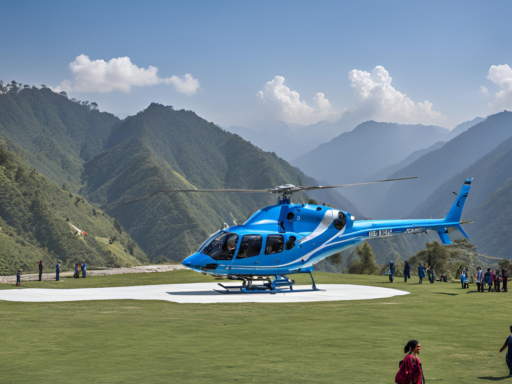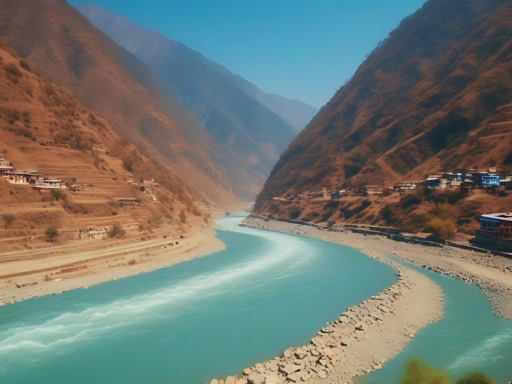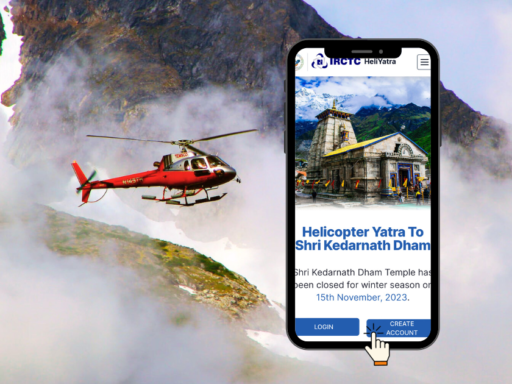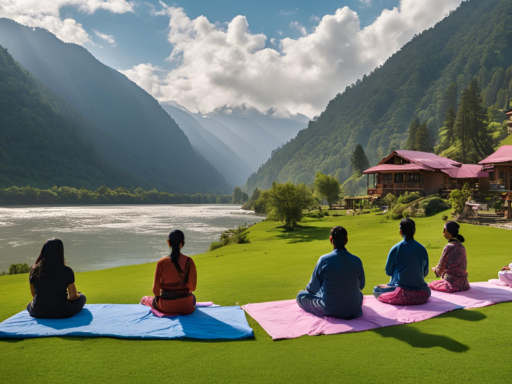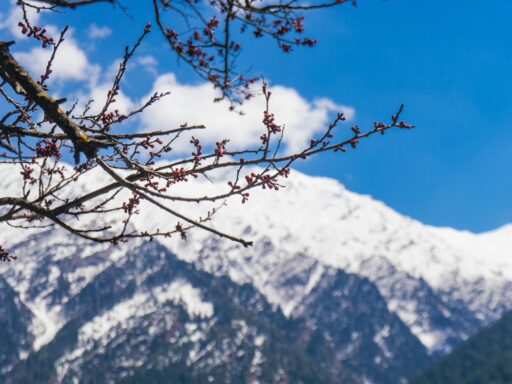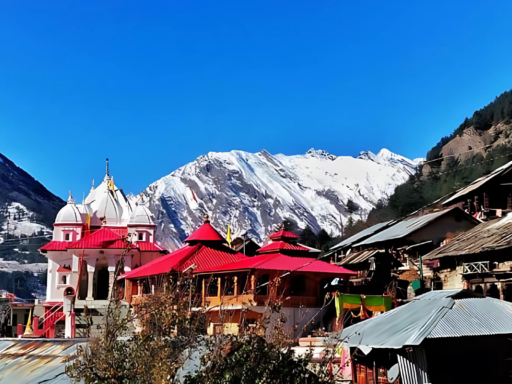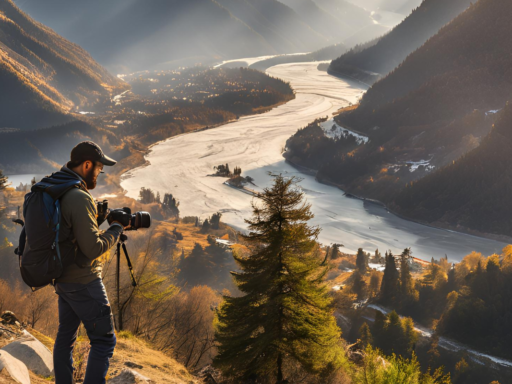Harsil Valley in Uttarakhand is a hidden gem offering breathtaking views year-round. Perched at an altitude of 2,620 meters (8,595 feet), the valley transforms from a snow-covered wonderland in winter, with temperatures plummeting to -10°C and snowfall reaching up to 4 feet, to a lush, sun-kissed paradise in summer, where temperatures hover between 10°C to 20°C. Surrounded by snow-capped peaks like Bandarpunch and Kedarnath Dome, and bisected by the serene Bhagirathi River, Harsil offers an idyllic escape for nature lovers and adventure seekers alike.
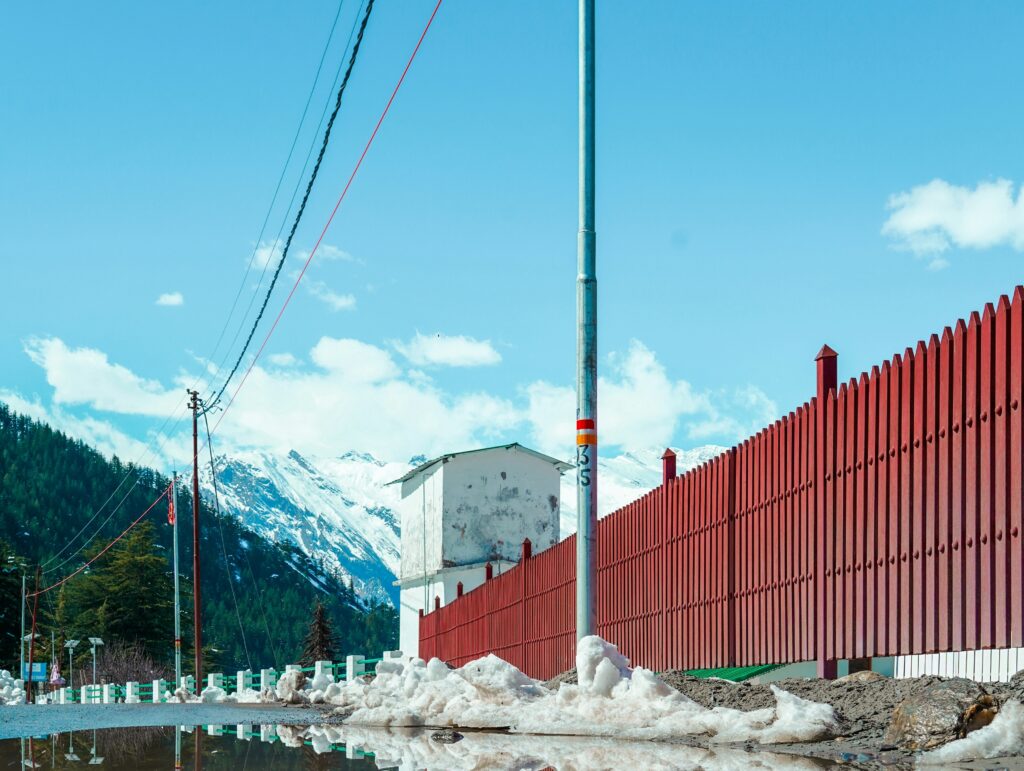
Spring Season in Harsil Valley Uttarakhand (March to April)
In spring, daytime temperature in Harsil valley ranges from 5°C to 15°C, and at night, they drop to around 0°C. As the snow melts, the valley turns green with blooming flowers, making it a great time for outdoor activities and sightseeing.

Best Time For:
Trekking: Spring is a great time for hiking and trekking, as the snow has mostly melted, and the weather is ideal for outdoor activities. Trails like the Sattal trek, which takes you to seven pristine lakes, are accessible and offer breathtaking views.
Nature Photography: The valley bursts into color with blooming flowers and lush greenery. This is a perfect time for nature enthusiasts and photographers to capture the beauty of the season.
Key Attractions:
Trekking and Hiking: Spring is ideal for those who enjoy trekking in milder weather. Trails are scenic, and rivers and streams flow with melting snow.
Gangotri National Park: Open during this period, the park’s biodiversity is on full display in the spring.
Travel Tip: Pack in layers, as the weather can be unpredictable. While daytime can be pleasant, mornings and evenings are still chilly. A light jacket, along with comfortable trekking shoes, is recommended.
Summer Season in Harsil Valley Uttarakhand (May to June)
Summer is arguably the best time to visit Harsil Valley, Daytime temperatures range from 10°C to 20°C, providing a much-needed respite from the heat in the plains. The skies are clear, offering stunning views of the surrounding snow-clad peaks, including Bandarpunch and Kedarnath Dome.
Best Time For:
Sightseeing: Summer is perfect for exploring the many attractions around Harsil, such as the Bhagirathi River, Gangotri, and the famous Harsil Apple Orchards. This is also the season when apple cultivation is in full swing.
Trekking and Adventure: Several trekking routes become accessible in summer, including the Gangotri Glacier trek, Gaumukh trek, and Dharali-Harsil-Gangotri trek. The lush green forests and riverside trails make the experience unforgettable.
Key Attractions:
Gangotri Temple: Only 25 kilometers from Harsil, the sacred Gangotri Temple opens its doors in May, drawing pilgrims and tourists alike. Visitors can stop at Harsil on their way to this revered Hindu site.
Harsil Apple Orchards: Introduced by British settler Frederick E. Wilson, the valley’s apple orchards are in full bloom during the summer. Visitors can take guided tours of these orchards and taste the locally grown apples.
Travel Tip: Since this is the peak tourist season, it’s advisable to book accommodations in advance. Carry sunscreen and a hat to protect yourself from the sun during long treks, but pack a jacket for the cooler evenings.
Monsoon Season in Harsil Valley Uttarakhand (July to September)
Monsoon season in Harsil Valley starts in early July and continues until September, with moderate to heavy rainfall, often exceeding 150 mm per month. Daytime temperatures range between 15°C and 20°C, though the frequent rain and cloudy skies can make it feel cooler. The rain transforms the valley into a lush green paradise but can also cause landslides and roadblocks, making travel challenging during this time.

Best Time For:
Relaxation: The monsoon is a quiet period in Harsil, with fewer tourists due to the weather. It’s a good time for those seeking solitude and tranquility. The rain enhances the natural beauty, making it a great time to enjoy peaceful retreats or homestays.
Nature Lovers: Monsoon brings out the rich greenery in the valley. The mountains, forests, and rivers take on a vibrant hue, making it a haven for nature lovers.
Key Attractions:
- Monsoon Scenery: The rain transforms the valley into a vibrant green paradise, with the Bhagirathi River flowing at its fullest. Waterfalls along the trekking paths are more active, providing stunning visuals for photographers and nature lovers.
- Peaceful Getaways: Fewer crowds make this a great time for those looking to escape the hustle and bustle. Homestays and cottages are perfect for spending quiet days surrounded by nature.
What to Avoid:
- Trekking: The heavy rains make trekking difficult and dangerous, as trails become slippery and prone to landslides.
- Traveling Long Distances: Landslides and roadblocks are common during the monsoon, especially on the routes leading to Gangotri. Always check weather and road conditions before planning your trip.
Travel Tip: Pack rain gear, including waterproof jackets and boots. Avoid long hikes or journeys, and keep updated with local weather conditions to avoid getting stranded due to landslides.
Autumn Season in Harsil Valley Uttarakhand (October to November)
In autumn, Harsil Valley experiences clear, cool weather with daytime temperatures ranging from 5°C to 15°C. The greenery changes to vibrant shades of gold and orange, making it a beautiful time for photography. The crisp air and clear skies also create perfect conditions for trekking and outdoor exploration.

Best Time For:
Trekking and Hiking: The cool, dry weather is ideal for long treks. Popular routes such as the Dharali-Gangotri trek and the Harsil Valley trek are less crowded and offer spectacular views.
Photography: The clear skies and autumn colors provide excellent opportunities for landscape and nature photography. The changing colors of the trees and the unobstructed views of the snow-capped peaks create picture-perfect moments.
Key Attractions:
- Gangotri Temple: Gangotri Temple remains open until early November, making this a good time for those who wish to combine spiritual tourism with their adventure.
- Apple Harvesting: Autumn is apple harvest season, and visitors can participate in picking fresh apples from the orchards.
Travel Tip: Though the days are pleasant, nights can get cold, with temperatures dropping close to freezing in late November. Make sure to pack warm clothing, especially if you plan to stay in outdoor lodges or campsites.
Winter Season in Harsil Valley Uttarakhand (December to February)
Winter in Harsil Valley brings heavy snowfall, creating a stunning winter landscape. Snow begins in early December and lasts until February, with the heaviest snowfall in January. Temperatures drop between -5°C and -10°C, and snow can accumulate up to 4 feet in some areas, making it a true winter wonderland.

Best Time For:
- Snow Lovers: If you love snow, Harsil in winter is a paradise. The valley is covered in a thick blanket of snow, offering picture-perfect scenery for winter photography and snow-related activities.
- Peace and Solitude: Winter is the quietest season in Harsil, as only a few tourists venture into the valley during this time. If you’re seeking solitude and want to experience the valley in its purest form, winter is the perfect time.
Key Attractions:
- Snow-Covered Landscapes: The entire valley is covered in snow, making it a beautiful destination for photographers and snow enthusiasts. The snow-clad peaks and frozen rivers add to the surreal beauty of the landscape.
- Winter Retreats: Several lodges and homestays in Harsil offer winter retreats where you can enjoy the serene beauty of the snow without venturing far into the cold.
What to Avoid:
- Trekking: Most trekking routes are closed due to heavy snowfall, and trekking in the deep snow is not recommended unless you are an experienced mountaineer.
- Gangotri Access: The road to Gangotri is often closed due to snow and ice, making it inaccessible during this period.
Travel Tip: Pack warm clothing, including thermals, woolen hats, gloves, and snow boots. Check road conditions before traveling, as heavy snowfall can block access to the valley.
Weather Chart of Harsil Valley Uttarakhand
here’s a graphical representation for weather in Harsil Valley Uttarakhand.

Harsil Valley Weather in January
January, The coldest month brings heavy snowfall in the valley with temperatures between -10°C and -5°C. Ideal for tourist seeking fresh snowfall, but travel may be limited due to snow-covered roads.
Harsil Valley Weather in February
Snow continues to fall February and temperatures remain low at -8°C to -2°C. Winter dominates with beautiful snow-covered landscapes, though accessibility can be difficult due to road closures.
Harsil Valley Weather in March
Spring begins in March and snow starts to melt. Temperatures range from 0°C to 10°C. The valley starts to bloom, making it a good time for trekking and nature walks.
Harsil Valley Weather in April
Daytime temperatures rise to 5°C to 15°C in April month, with clear skies and mild weather. Snow has melted, and the valley bursts into greenery, ideal for outdoor activities and sightseeing.
Harsil Valley Weather in May
May arrives with pleasant summer weather, 10°C to 20°C. Clear skies and mild temperatures make it perfect time to visit Harsil valley. Attractions like Gangotri Temple, Gartang Gali, Nelong Valley and Gangotri National Park are very popular.
Harsil Valley Weather in June
June brings warm days with temperatures between 15°C and 20°C. Summer is in full swing, and the valley is popular with tourists, offering excellent trekking conditions and stunning views of the Himalayas.
Harsil Valley Weather in July
July’s monsoon brings refreshing rains and transforms the valley into a lush green paradise, with temperatures ranging from 15°C to 20°C, While landslides and roadblocks can make travel adventurous.
Harsil Valley Weather in August
Monsoon in August continues bringing frequent rainfall and cooler temperatures around 14°C to 19°C. The valley remains vibrant, but trekking and long journeys should be avoided due to slippery trails.
Harsil Valley Weather in September
Monsoon in September starts to retreat with occasional rain and temperatures around 15°C to 20°C. The valley remains green, but weather improves, allowing for safer travel and nature walks.
Harsil Valley Weather in October
October is Cool, clear and weather returns with temperatures between 5°C and 15°C. The beautiful autumn leaves make it a great time for trekking, sightseeing, and taking photos.
Harsil Valley Weather in November
In November the temperatures drop to 0°C to 10°C, and the valley prepares for winter. Crisp, clear days with fewer crowds make it an ideal time for trekking and visiting apple orchards before snow arrives.
Harsil Valley Weather in December
December winter begins with snowfall and temperatures range from -5°C to 0°C. The valley becomes a winter wonderland, perfect for snow lovers, though road access may be limited by snow.

What is the best time to visit Harsil Valley for pleasant weather?
The best time to visit Harsil is from April to June and October to November when the weather is mild, with temperatures ranging from 10°C to 20°C, perfect for outdoor activities and sightseeing.
When does it snow in Harsil Valley Uttarakhand?
Snowfall occurs in Harsil from December to March, with peak snowfall in January. The valley transforms into a winter wonderland during this period, making it a popular destination for snow lovers.
How cold does it get in Harsil Valley during winter?
Winter temperatures in Harsil Valley drop as low as -10°C, especially during December and January, with snow covering the valley. Visitors should be prepared for extremely cold weather conditions.
What is the average temperature in Harsil Valley in summer?
The average summer temperature in Harsil Valley, from April to June, ranges between 10°C and 20°C, making it a pleasant and cool escape from the heat of the plains.
How much snowfall does Harsil Valley receive annually?
Harsil Valley typically receives around 3-4 feet of snowfall during the winter months, from December to February, which enhances the valley’s beauty but can make certain areas inaccessible.
What is the weather like in Harsil Valley during the monsoon?
Harsil experiences heavy rainfall during the monsoon season, which lasts from July to September. Landslides and roadblocks are common, making travel during this time challenging.
Is Harsil Valley accessible during the winter months?
Harsil remains accessible during early winter, but heavy snowfall from January to March can block roads, particularly the route to Gangotri, so travelers should check road conditions before planning their visit.
How does the weather in Harsil Valley affect trekking routes?
Trekking in Harsil is best during April to June and October to November when the weather is clear and cool. Snow and rain in winter and monsoon make trekking difficult and dangerous.
What is the typical weather in Harsil Valley during April and May?
In April and May, the weather in Harsil is cool and comfortable, with daytime temperatures ranging from 10°C to 15°C. It’s an ideal time for trekking and exploring the valley’s natural beauty.
Does Harsil Valley experience heavy rainfall during the monsoon?
Yes, Harsil experiences heavy rainfall from July to September, which can lead to landslides and roadblocks. Travelers should avoid visiting during this time due to difficult road conditions.
When does the monsoon season start in Harsil Valley?
The monsoon in Harsil Valley starts in early July and lasts until mid-September. This period sees heavy rainfall, making travel and outdoor activities challenging due to slippery terrain and landslides.
How can travelers prepare for winter weather in Harsil Valley?
Travelers should pack warm clothing, including thermal layers, gloves, and snow boots, as winter temperatures drop to -10°C. Checking road conditions before travel is essential due to potential snow blockages.
Is summer the best time to explore Harsil Valley?
Yes, summer, from April to June, offers the best weather to explore Harsil Valley. With temperatures ranging from 10°C to 20°C, it’s perfect for trekking, sightseeing, and outdoor activities.
What is the temperature range in Harsil Valley during spring?
During March and April, temperatures in Harsil range between 5°C and 15°C. This season marks the end of winter, offering milder weather with blooming landscapes, ideal for exploring the valley.
How does the altitude of Harsil Valley affect its weather patterns?
Harsil’s altitude of 2,620 meters (8,595 feet) leads to cooler weather year-round. Winters are snowy and cold, summers are mild, and weather conditions can change quickly due to the high altitude.
Can tourists visit Harsil Valley in December despite the cold weather?
Yes, tourists can visit Harsil in December, but they must be prepared for temperatures dropping to -10°C. Early December is more accessible, while heavy snow later in the month can limit travel.
What clothing should one pack for a winter trip to Harsil Valley?
For a winter trip, pack warm layers, thermals, snow boots, woolen caps, gloves, and a good winter jacket. Temperatures drop below -10°C, and snow is common during December to March.
Does Harsil Valley have clear skies in autumn?
Yes, Harsil Valley enjoys clear skies in autumn, from October to November, with pleasant temperatures ranging between 5°C and 15°C, making it an ideal time for outdoor activities and photography.
What are the daytime temperatures in Harsil Valley during summer?
During the summer months of April to June, daytime temperatures in Harsil Valley range from 10°C to 20°C, offering cool and pleasant weather, perfect for sightseeing and trekking.
How does winter weather impact transportation to Harsil Valley?
Heavy snowfall during winter, especially from January to March, can cause road closures and make travel difficult. It’s essential to check road conditions before planning a trip in winter.
What months are the warmest in Harsil Valley?
The warmest months in Harsil Valley are May and June, with daytime temperatures ranging between 15°C and 20°C. These months offer the most comfortable weather for visitors.
Is Harsil Valley safe to visit during the rainy season?
Harsil Valley is prone to landslides during the rainy season from July to September, making travel risky. It’s best to avoid visiting during monsoon to ensure safety and smooth travel.
How long does the snow season last in Harsil Valley?
The snow season in Harsil Valley lasts from December to March, with peak snowfall occurring in January and February. Snowfall makes the valley a winter destination but also complicates travel.
What kind of weather can visitors expect in Harsil Valley in October?
October in Harsil Valley brings cool temperatures ranging from 5°C to 15°C, with clear skies and mild weather, making it ideal for trekking and sightseeing before the winter snow begins.
Does the weather in Harsil Valley vary drastically from season to season?
Yes, Harsil experiences distinct seasonal changes, from mild summers and heavy monsoon rains to snowy, cold winters and crisp autumns. Each season offers a different experience of the valley.
How cold is Harsil Valley at night during the summer?
Even during summer, nights in Harsil Valley can be chilly, with temperatures dropping to around 5°C to 10°C, so visitors should bring light layers for warmth.
Are there any weather-related travel restrictions in Harsil Valley?
In winter, heavy snowfall can lead to road closures, particularly towards Gangotri. During the monsoon, landslides are common, which may result in travel restrictions. Always check local weather conditions.
What is the weather forecast for Harsil Valley in November?
In November, Harsil Valley experiences cool temperatures ranging between 5°C and 10°C during the day. The weather is crisp, with clear skies, but nights can be much colder, nearing freezing.
How does the weather in Harsil Valley impact local tourism?
Weather greatly impacts tourism in Harsil. Summer and autumn attract the most visitors due to pleasant conditions, while winter’s heavy snow and the monsoon’s rainfall limit travel and activities.
Is Harsil Valley ideal for winter sports activities like skiing?
Harsil Valley, with its heavy snowfall from December to March, has potential for winter sports like skiing, though it’s not yet a fully developed winter sports destination.
What’s the average temperature in Harsil Valley during the monsoon?
During the monsoon season (July to September), temperatures in Harsil Valley range from 15°C to 20°C. However, frequent rainfall and cloudy weather dominate this period.
What is the coldest month in Harsil Valley?
The coldest month in Harsil Valley is typically January, with temperatures dropping as low as -10°C and heavy snowfall blanketing the valley.
Does Harsil Valley experience any extreme weather conditions?
Harsil Valley experiences extreme cold in winter, with temperatures dropping below -10°C and heavy snowfall. Monsoon rains (July-September) can also trigger landslides, making travel hazardous.
How does the weather in Harsil Valley compare to other hill stations in Uttarakhand?
Harsil’s weather is cooler and more isolated compared to popular hill stations like Mussoorie or Nainital, with colder winters and heavier snowfall due to its higher altitude.
Can you camp in Harsil Valley during winter?
Winter camping in Harsil Valley is possible but challenging due to -10°C temperatures and heavy snowfall. Proper winter camping gear is essential, and it’s best suited for experienced campers.
What’s the humidity level in Harsil Valley during summer?
Humidity levels in Harsil Valley during summer are generally low, making it feel cooler and more comfortable, with pleasant daytime temperatures ranging from 10°C to 20°C.
How sunny is Harsil Valley during the spring months?
Harsil Valley enjoys clear, sunny days during spring (March-April), with temperatures ranging from 5°C to 15°C. The valley’s blooming flowers and lush greenery make this a beautiful time to visit.
When does the snow start melting in Harsil Valley?
Snow in Harsil Valley begins to melt in March, as temperatures rise and winter transitions into spring. By late April, most of the valley is clear of snow.
Is there a risk of avalanches in Harsil Valley during winter?
While Harsil Valley does experience heavy snowfall, avalanches are not commonly reported. However, snow accumulation on mountain slopes poses some risk, especially in remote trekking areas.
How does the weather in Harsil Valley affect apple farming?
Harsil’s cold winters and cool summers provide ideal conditions for apple farming. Apple harvest season typically begins in late August and continues until October, benefiting from the mild autumn weather.
What precautions should travelers take during the monsoon in Harsil Valley?
Travelers visiting during the monsoon (July-September) should be cautious of landslides and slippery roads. It’s advisable to check road conditions, avoid trekking, and carry rain gear for sudden downpours.
How windy does it get in Harsil Valley during winter?
Winter in Harsil Valley can be accompanied by strong winds, especially during snowstorms, which make the cold feel more intense. Wind speeds vary but can reach up to 15-20 km/h during storms.
Does Harsil Valley have frost in early spring?
Yes, Harsil Valley can experience frost during early spring, particularly in March, when temperatures still drop near freezing at night, while daytime temperatures begin to warm up.
How hot can it get in Harsil Valley during peak summer?
During peak summer in May and June, daytime temperatures in Harsil Valley can reach 20°C, but it remains much cooler than the plains, making it a popular summer retreat.
Is Harsil Valley foggy during the monsoon season?
Yes, the monsoon season (July-September) often brings fog to Harsil Valley, particularly in the mornings and evenings, reducing visibility and making travel more difficult.
What are the weather conditions in Harsil Valley like in September?
September in Harsil marks the end of the monsoon, with moderate rainfall and temperatures between 15°C and 20°C. It’s the beginning of autumn, making it a transitional month with occasional showers.
Can one hike in Harsil Valley during the winter season?
Hiking in Harsil during winter (December to March) is possible, but challenging due to snow-covered trails and freezing temperatures. It’s recommended only for experienced trekkers with proper winter gear.
How does climate change impact the weather patterns in Harsil Valley?
Climate change has led to unpredictable weather patterns in Harsil Valley, including warmer winters, increased rainfall, and shifting snow seasons. These changes impact both local agriculture and tourism.



